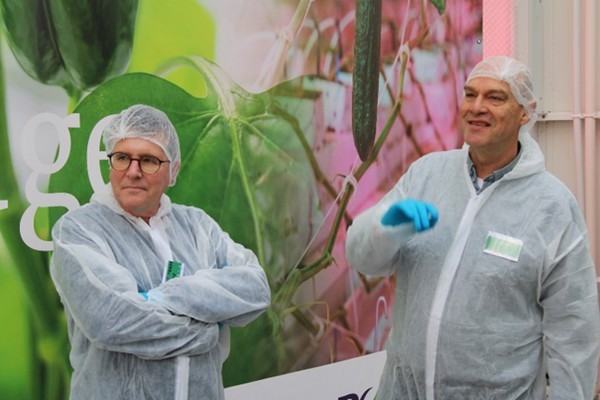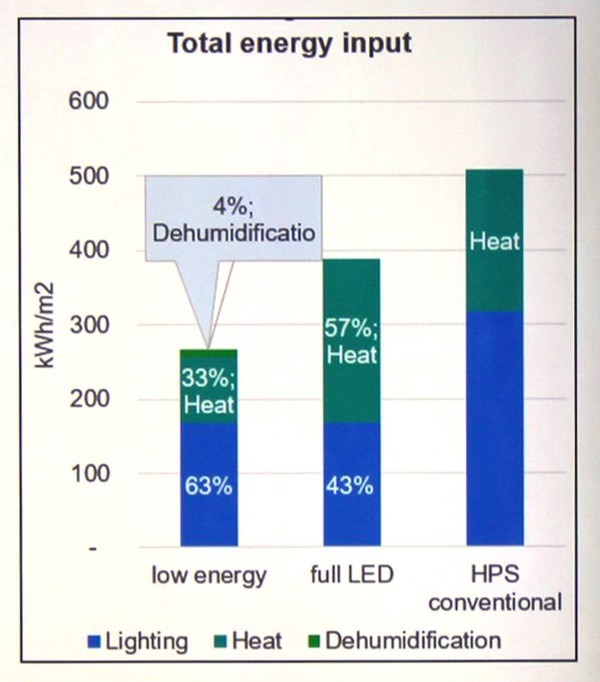The second year of Grodan and Philips' energy-efficient tomato trial was presented last Wednesday, with interim results on energy consumption, light recipes, nutritional treatments, and dehumidification also shared. This is now possible as the second year of the trial to grow tomatoes in an energy-efficient manner is in full swing.
Grodan and Philips have already gained good insight in their first year by exploring extremes. The results were strikingly positive. More seems possible, so a continuation of that first year is a logical step.
 Marcel Raats (Philips) and Jos Beerens (Grodan). View a photo report of the event here.
Marcel Raats (Philips) and Jos Beerens (Grodan). View a photo report of the event here.
In 2024-2025, the extremes from the first season will become the standard. The question is: How far can we go? Where are the real limitations—or rather, the optimum—when using full LED lighting?
Screens
The focus of the trial this season is on flavor, fruit quality, and weight. It also examines further savings on heating costs. The higher insulation values of the screens have been considered. Joost Veenman, Knight, discusses the use of the screens. "The fabric is kept closed as much as possible to save energy. We only open the fabric for compelling reasons, and so that happens extremely rarely. It's almost like an indoor crop. The advantage is that predictability becomes great. Every day is the same."
Nutrients
And speaking of extremes, nutrient treatment in this trial crop is also becoming more extreme. Ruud Kaarsemaker, Normec, is the person who can tell all about nutrient uptake in this trial. "Both the nutrient uptake and the amount of nutrients not taken up are measured. The element uptake responds to each other. The relative proportions of the different elements affect the uptake. And we also see that limiting nitrogen results in a more generative crop," he informed the group of growers present.
Another adjustment is that the inlet of outside air is no longer allowed below the greenhouse temperature. That cost too much energy. More attention is being paid to vertical plant temperature distribution this year in connection with cold heads.
LED
Philips is using 3-channel lamps in this trial. Marcel Raats, Philips, says that sometimes a channel is closed simply because it is not needed by the crop. The first energy gain is a fact. "The crop is fed a strict regime of light: in the early evening, 5% blue/green light and later, a normal spectrum. During the day, the lamps are on the red channel for 6 hours."
Marcel stresses that this is not advice but a test. By the way, they haven't seen any difference from last year. And for the last two weeks, they have even switched back to 3% blue/green light. "We are curious to see what that will do."
It does say that the light spectrum affects the bumblebee population. This has also been tested. Marcel: "It's more like we can help bumblebees by adjusting the humidity rather than the light."
Watering
Grodan is looking for the optimal watering in this trial. Jos Beerens, Grodan: "To determine that, we put the plant at the center. The GroSens sensors helped determine the optimal watering rate. Jos indicates that growers are especially happy with a large root system. Yet, there is a catch there. In lighted cultivation, we sometimes see such an extensive root system that it gets in the way. All the energy then goes to the roots. That is not the intention."
The optimal watering is important to know to save water and energy. Last year, we managed to grow for 8 to 9 weeks even without a drain.

Only 4% energy is needed for active dehumidification in this low-energy tomato trial
Data
No trial is complete without substantiation. That means collecting data. The test greenhouse at Botany is full of sensors from Wireless Value, Grodan (Grosens), and DLI controller (Ridder). It generates a mountain of data. Linking these data together releases a lot of information. This will enable the sector to move forward.
View a photo impression of the event here.
For more information:
Grodan
Andrew Lee
andrew.lee@grodan.com
Philips
Marcel Raats
Marcel.raats@signify.com
